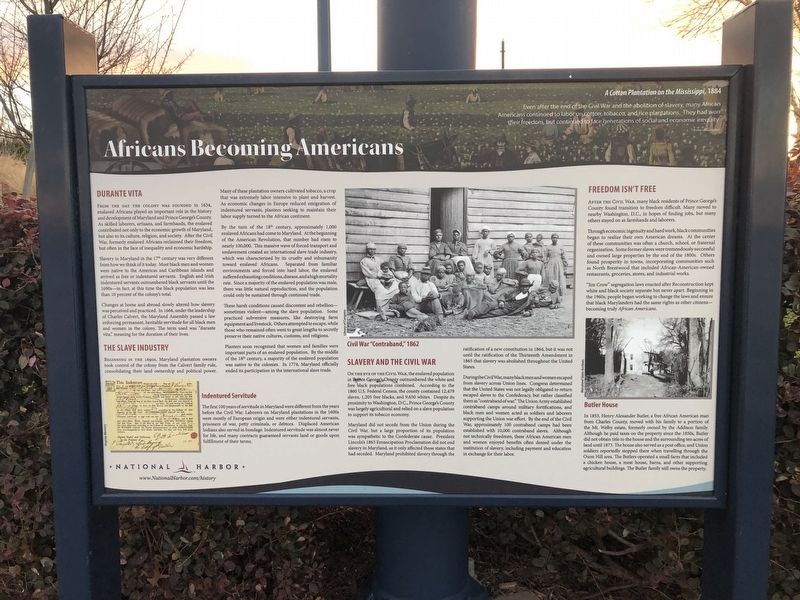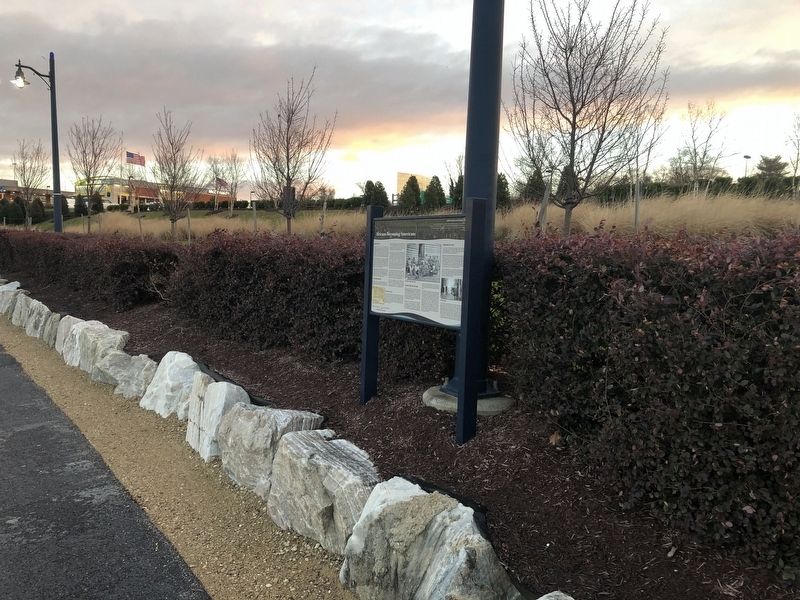Forest Heights in Prince George's County, Maryland — The American Northeast (Mid-Atlantic)
Africans Becoming Americans

Photographed By Devry Becker Jones (CC0), December 22, 2018
1. Africans Becoming Americans Marker (click on picture for enlarged version of marker)
Durante Vita
From the day the colony was founded in 1634, enslaved Africans played an important role in the history and development of Maryland and Prince George's County. As skilled laborers, artisans, and farmhands, the enslaved contributed not only to the economic growth of Maryland, but also to its culture, religion, and society. After the Civil War, formerly enslaved Africans reclaimed their freedom but often in the face of inequality and economic hardship.
Slavery in Maryland in the 17th century was very different from how we think of it today. Most black men and women were native to the Americas and Caribbean islands and arrived as free or indentured servants. English and Irish indentured servants outnumbered black servants until the 1690s–in fact, at this time the black population was less than 10 percent of the colony's total.
Changes at home and abroad slowly altered how slavery was perceived and practiced. In 1664, under the leadership of Charles Calvert, the Maryland Assembly passed a law enforcing permanent, heritable servitude for all black men and women in the colony. The term used was "durante vita," meaning the duration of their lives.
The Slave Industry
Beginning in the 1690s, Maryland plantation owners took control of the colony from the Calvert family rule, consolidating their land ownership and political power.
Many of these plantation owners cultivated tobacco, a crop that was extremely labor intensive to plant and harvest. As economic changes in Europe reduced emigration of indentured servants, planters seeking to maintain their labor supply turned to the African continent.
By the turn of the 18th century, approximately 1,000 enslaved Africans had come to Maryland. At the beginning of the American Revolution, that number had risen to nearly 100,000. This massive wave of forced transport and enslavement created an international slave trade industry, which was characterized by its cruelty and inhumanity toward enslaved Africans. Separated from familiar environments and forced into hard labor, the enslaved suffered exhausting conditions, disease, and a high mortality rate. Since a majority of the enslaved population was male, there was little natural reproduction, and the population could only be sustained through continued trade.
These harsh conditions caused discontent and rebellion–sometimes violent–among the slave population. Some practiced subversive measures, like destroying farm equipment and livestock. Others attempted to escape, while those who remained often went to great lengths to secretly preserve their native cultures, customs, and religions.
Planters
Slavery and the Civil War
On the eve of the Civil War, the enslaved population in Prince George's County outnumbered the white and free black populations combined. According to the 1860 U.S. Federal Census, the county contained 12,479 slaves, 1,205 free blacks, and 9,650 whites. Despite its proximity to Washington, D.C., Prince George's County was largely agricultural and relied on a slave population to support its tobacco economy.
Maryland did not secede from the Union during the Civil War, but a large proportion of its population was sympathetic to the Confederate cause. President Lincoln's 1863 Emancipation Proclamation did not end slavery in Maryland, as it only affected those states that had seceded. Maryland prohibited slavery through the ratification of a new constitution in 1864, but it was not until the ratification of the Thirteenth Amendment in 1865 that slavery was abolished throughout the United States.
During the Civil War, many black men and women escaped from slavery across Union lines. Congress determined that the United States was not obligated to return escaped slaves to the Confederacy, but rather classified them as "contraband of war." The Union Army established contraband camps around military fortifications, and black men and women acted as soldiers and laborers supporting the Union war effort. By the end of the Civil War, approximately 100 contraband camps had been established with 10,000 contraband slaves. Although not technically freedmen, these African American men and women enjoyed benefits often denied under the institution of slavery, including payment and education in exchange for their labor.
Freedom Isn't Free After the Civil War, many black residents of Prince George's County found transition to freedom difficult. Many moved to nearby Washington, D.C., in hopes of finding jobs, but many others stayed on as farmhands and laborers.
Through economic ingenuity and hard work, black communities began to realize their own American dreams. At the center of these communities was often a church, school, or fraternal organization. Some former slaves were tremendously successful and owned large properties by the end of the 1800s. Others found prosperity in towns, incorporating communities such as North Brentwood that included African-American-owned restaurants, groceries, stores, and industrial works.
"Jim Crow" segregation laws enacted after Reconstruction kept white and black society separate but never apart. Beginning in the 1960s, people began working to change the laws and ensure that black Marylanders had the same rights as other citizens–becoming truly African Americans.
[Captions:]
A Cotton Plantation on the Mississippi, 1884
Even after the end of the Civil War and the abolition of slavery, many African Americans continued to labor on cotton, tobacco, and rice plantations. They had won their freedom, but continued to face generations of societal and economic inequity.
Indentured Servitude
The first 100 years of servitude in Maryland were different from the years before the Civil War. Laborers on Maryland plantations in the 1600s were mostly of European origin and were either indentured servants, prisoners of war, petty criminals, or debtors. Displaced American Indians also served in bondage. Indentured servitude was almost never for life, and many contracts guaranteed land or goods upon fulfillment of their terms.
Butler House
In 1853, Henry Alexander Butler, a free African American man from Charles County, moved with his family to a portion of the Mt. Welby estate, formerly owned by the Addison family. Although he paid taxes on the property since the 1850s, Butler did not obtain the title to the house and surrounding ten acres of land until 1873. The house also served as a post office, and Union soldiers reportedly stopped there when travelling through the Oxon Hill area. The Butlers operated a small farm that included a chicken house, a meat house, barns, and other supporting agricultural buildings. The Butler family still owns the property.
Topics and series. This historical marker is listed in these topic lists: Abolition & Underground RR • African Americans • Civil Rights • Industry & Commerce. In addition, it is included in the Former U.S. Presidents: #16 Abraham Lincoln series list. A significant historical year for this entry is 1634.
Location. 38° 47.315′ N, 77° 0.853′ W. Marker is in Forest Heights, Maryland, in Prince George's County. Marker can be reached from National Harbor Boulevard south of Capital Beltway (Interstate 95), on the right when traveling south. Touch for map. Marker is at or near this postal address: 7200 Harborview Ave, Oxon Hill MD 20745, United States of America. Touch for directions.
Other nearby markers. At least 8 other markers are within walking distance of this marker. The Architecture of Oxon Hill Manor (within shouting distance of this marker); After the Addisons (about 400 feet away, measured in a direct line); The First People (about 400 feet away); Archaeology at Oxon Hill (about 600 feet away); Franklin D. Roosevelt (about 800 feet away); Dwight D. Eisenhower (about 800 feet away); Discover Gorgeous Southern Prince George's (approx. ¼ mile away); Skipjacks (approx. ¼ mile away). Touch for a list and map of all markers in Forest Heights.
Credits. This page was last revised on July 17, 2022. It was originally submitted on December 22, 2018, by Devry Becker Jones of Washington, District of Columbia. This page has been viewed 408 times since then and 11 times this year. Last updated on July 16, 2022, by Carl Gordon Moore Jr. of North East, Maryland. Photos: 1, 2. submitted on December 22, 2018, by Devry Becker Jones of Washington, District of Columbia.
